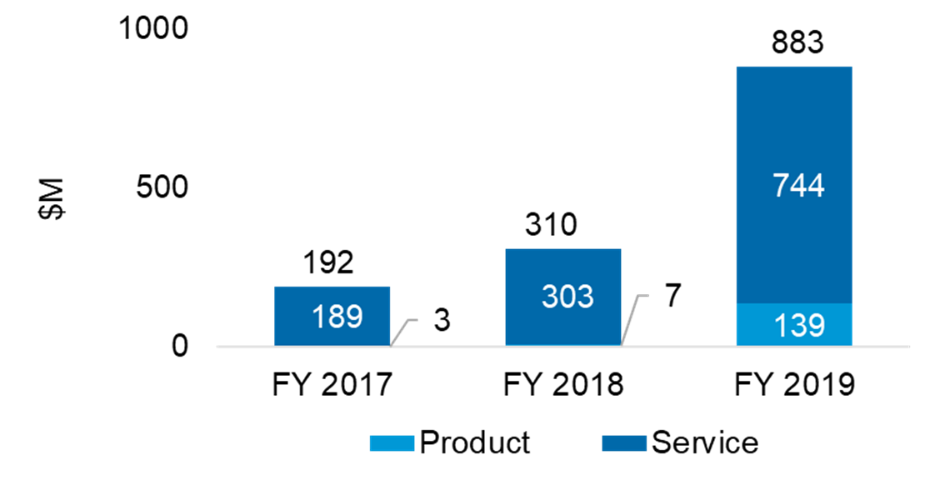AI’s Continued Role in COVID-19 Response
Published: May 01, 2020
Federal Market AnalysisArtificial Intelligence/Machine LearningCoronavirus (COVID-19) PandemicForecasts and SpendingHealth ITSpending Trends
Autonomous unmanned systems and machine learning play large roles in the heart of the response to COVID-19.
Key Takeaways:
- AI has proven instrumental in the response to COVID-19, from helping to track the outbreak to disinfecting contaminated areas.
- AI continues to revolutionize the health care environment in two main ways when it comes to the current pandemic - directly assisting medical workers with autonomous systems and heavily used by scientists accelerate research of the disease through machine learning.
- Federal Spending in AI increased from $192M in FY 2017 to $883M in FY 2019, however the coronavirus pandemic will further expand federal investment in AI programs, particularly in areas of R&D and health care.
Artificial Intelligence (AI) technologies have been involved with COVID-19 since onset of the pandemic, and AI use has amplified since then. When I previously explored AI’s role in the novel coronavirus, the technology was helping to track the outbreak, provide patient diagnosis, disinfect contaminated areas, and used in scientific research to find a cure to the dramatic disease.
As the pandemic continues to unfold, so has the use of AI technologies to fight the crisis. In fact, AI technologies are now at the crux of the pandemic – assisting healthcare professionals through autonomous systems and helping scientists research every aspect of the disease with machine learning (ML).
Autonomous Systems
A virus with a large contagion, such as that of the coronavirus, puts to work autonomous, unmanned machines in a variety of settings. In particular, autonomous machines have helped ease the strain on health care resources and personnel during this pandemic.
For example, the Jacksonville Transportation Authority is piloting autonomous vehicles to deliver COVID-19 tests. The unmanned vehicles navigate across a medical campus to transport tests from a drive-thru clinic to a processing lab, saving health workers time and energy in processing the tests.
Moreover, robots are being widely used across various COVID-related environments including public health and safety, clinical care, and laboratory and supply chain automation. For instance, another GCN article cites that health care workers use robots in treatment rooms to remotely take temperatures and measure blood pressure and oxygen on patients with ventilators. AI and ML have the potential to take the task performance of robots in COVID situations a step further by “teaching” the machines to react in certain medical scenarios, thereby further relieving the workload of personnel and directing their attention to more critical situations.
Scientific Research
In late March, the White House announced the COVID-19 High Performance Computing (HPC) Consortium to bring together supercomputing resources at federal agencies, academia and industry for critical research related to the virus. Since then, the consortium has pursued 33 separate COVID-19 research projects, many of them relying on AI:
- COVID-19 novel molecule generation with reinforced learning. Utilizes neural network capabilities to help researchers generate novel molecules to estimate binding affinities to target proteins and other drug-related properties to assist in finding a cure to COVID-19.
- Discovering molecular targets of the human coronavirus with HPC and AI. AI-driven HPC work will help identify specific regions of the SARS-CoV-2 spike protein, leading to potential drug targets for COVID.
- High Accuracy Modeling of SARS-CoV-2 Membrane Proteins via ML and Physics-Based Refinement. Applies computational prediction methods to deliver high-resolution structural models for specific proteins in SARS-CoV-2.
- Drug-repurposing for Covid-19 with 3D-aware machine learning. A combination of physical simulation and ML help to accelerate the repurpose of drugs for COVID-19 treatment.
Federal AI Spending
Aside from the above examples, federal agencies are announcing additional AI programs to help respond to COVID-19. At HHS for example, Protect Now is a new platform that will use AI to aggregate several disparate data to help agency officials visually track, mitigate and respond to the virus.
Last month, Deltek released the Federal Artificial Intelligence Landscape, 2021 report. In it, the report includes a thorough spending analysis of the federal AI market. From FY 2017 to 2019, federal spending in AI rose 360% in contract obligations.

Source: Deltek, FPDS
Analysis shows that Research and Development (R&D) requirements represented 79% of the total AI market in the three-year period. This signifies a continued commitment by the federal space to pursue and integrate AI technologies into agency missions and processes. Autonomous-related requirements in the spending data ranged from autonomous planning systems to unmanned weapons systems and space vehicles, totaling $854M from FY 2017 to 2019.
Looking Ahead
Certainly as social distancing and health precautions mount throughout the U.S., unmanned and autonomous system will become increasingly important not only in the health care space, but in daily lives. Additionally, the urgency to find a cure to mitigate the effects of the virus and save lives will continue to push AI into the research spotlight, helping scientists quickly model, decipher and compute different aspects of potential vaccines. Given this, and with the federal AI market already flourishing in the federal space in R&D and autonomous systems in the pre-COVID era, there is sound argument that the novel coronavirus pandemic will likely cause further federal investment in AI technologies as the pandemic progresses and even thereafter.